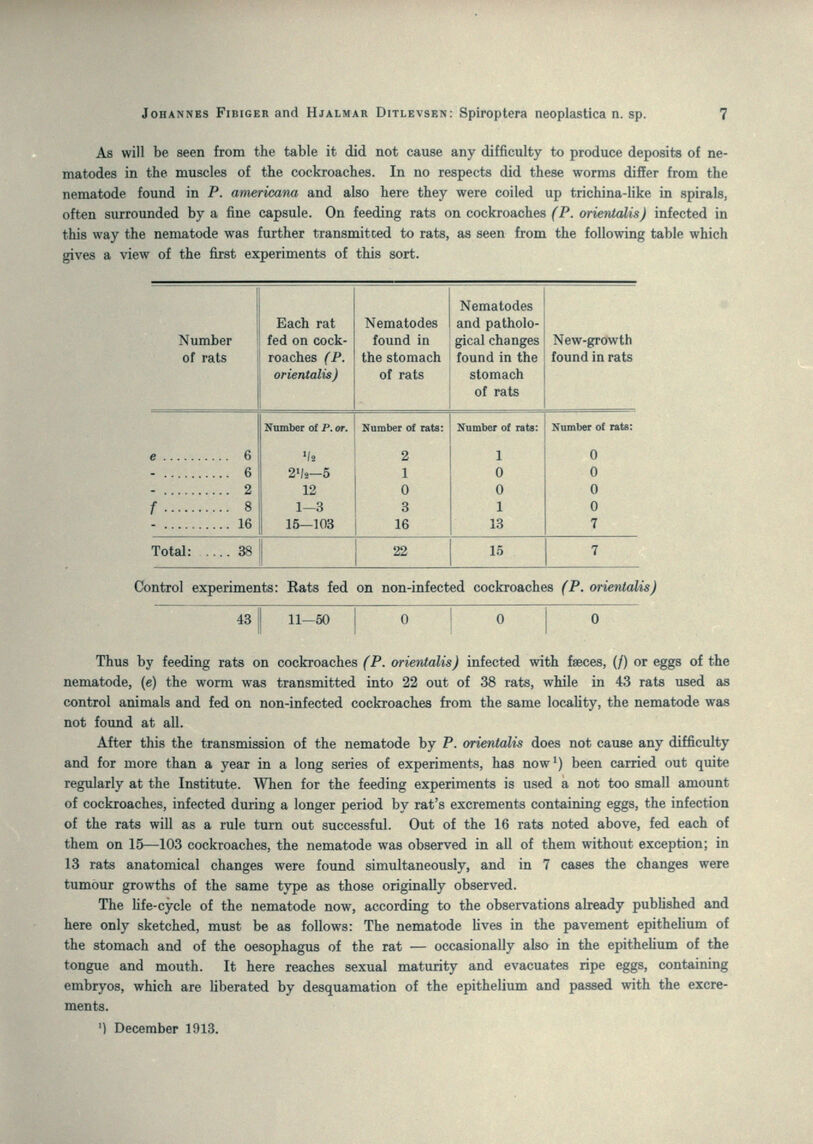
Full resolution (JPEG) - On this page / på denna sida - Contributions to the Biology and Morphology of Spiroptera (Gongylonema) Neoplastica n. sp.

<< prev. page << föreg. sida << >> nästa sida >> next page >>
Below is the raw OCR text
from the above scanned image.
Do you see an error? Proofread the page now!
Här nedan syns maskintolkade texten från faksimilbilden ovan.
Ser du något fel? Korrekturläs sidan nu!
This page has never been proofread. / Denna sida har aldrig korrekturlästs.
As will be seen from the table it did not cause any difficulty to produce deposita of ne-
matodes in the muscles of the cockroaches. In no respects did these worms differ from the
nematode found in P. americana and also here they were coiled up trichina-like in spirals,
often surrounded by a fine capsule. On feeding rats on cockroaches (P. orientalis) infected in
this way the nematode was f urther transmitced to rats, as seen from the following table which
gives a view of the first experiments of this sort.
Number
of rats
Each rat
fed on cock-
roaches (P.
orientalis)
i Nematodes
found in
’ the stomach
of rats
Nematodes
and patholo-
gical changes
New-growth
found in the found in rats
stomach 1
of rats I
6
6
2
8
16
Number of P. or. Nnmber of rats: Number of rats: Number of rats:
Total:
38
2»/2-5
12
1—3
15—103
2
1
O
3
16
22
1
O
O
1
13
15
Control experiments: Rats fed on non-infected cockroaches (P. orientalis)
43
11—50
O
O
O
Thus by feeding rats on cockroaches (P. orientalis) infected with fæces, (/) or eggs of the
nematode, (e) the worm was transmitted into 22 out of 38 rats, while in 43 rats used as
Control animals and fed on non-infected cockroaches from the same locaUty, the nematode was
not found at all.
After this the transmission of the nematode by P. orientalis does not cause any difficulty
and for more than a year in a long series of experiments, has now*) been carried out quite
regularly at the Institute. When for the feeding experiments is used a not too small amount
of cockroaches, infected during a longer period by rat’s excrements containing eggs, the infection
of the rats will as a rule turn out successful. Out of the 16 rats noted above, fed each of
them on 15 — 103 cockroaches, the nematode was observed in all of them without exception; in
13 rats anatomicai changes were found simultaneously, and in 7 cases the changes were
tumour growths of the same type as those originally observed.
The Ufe-cycle of the nematode now, according to the observations already pubhshed and
here only sketched, must be as follows: The nematode Uves in the pavement epithelium of
the stomach and of the oesophagus of the rat — occasionally also in the epithelium of the
tongue and mouth. It here reaches sexual maturity and evacuates ripe eggs, containing
embryos, which are liberated by desquamation of the epithelium and passed with the excre-
ments.
’) December 1913.
<< prev. page << föreg. sida << >> nästa sida >> next page >>